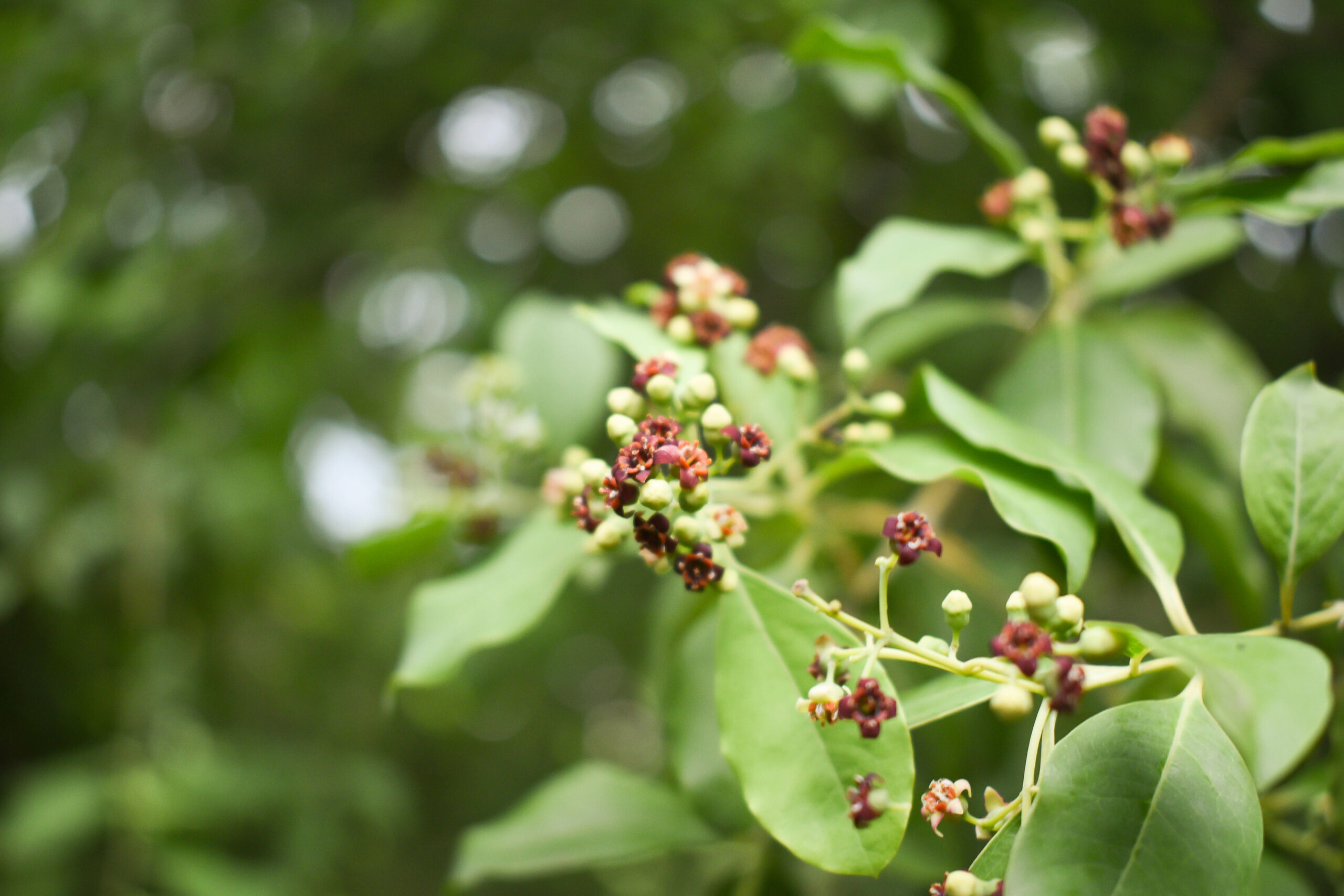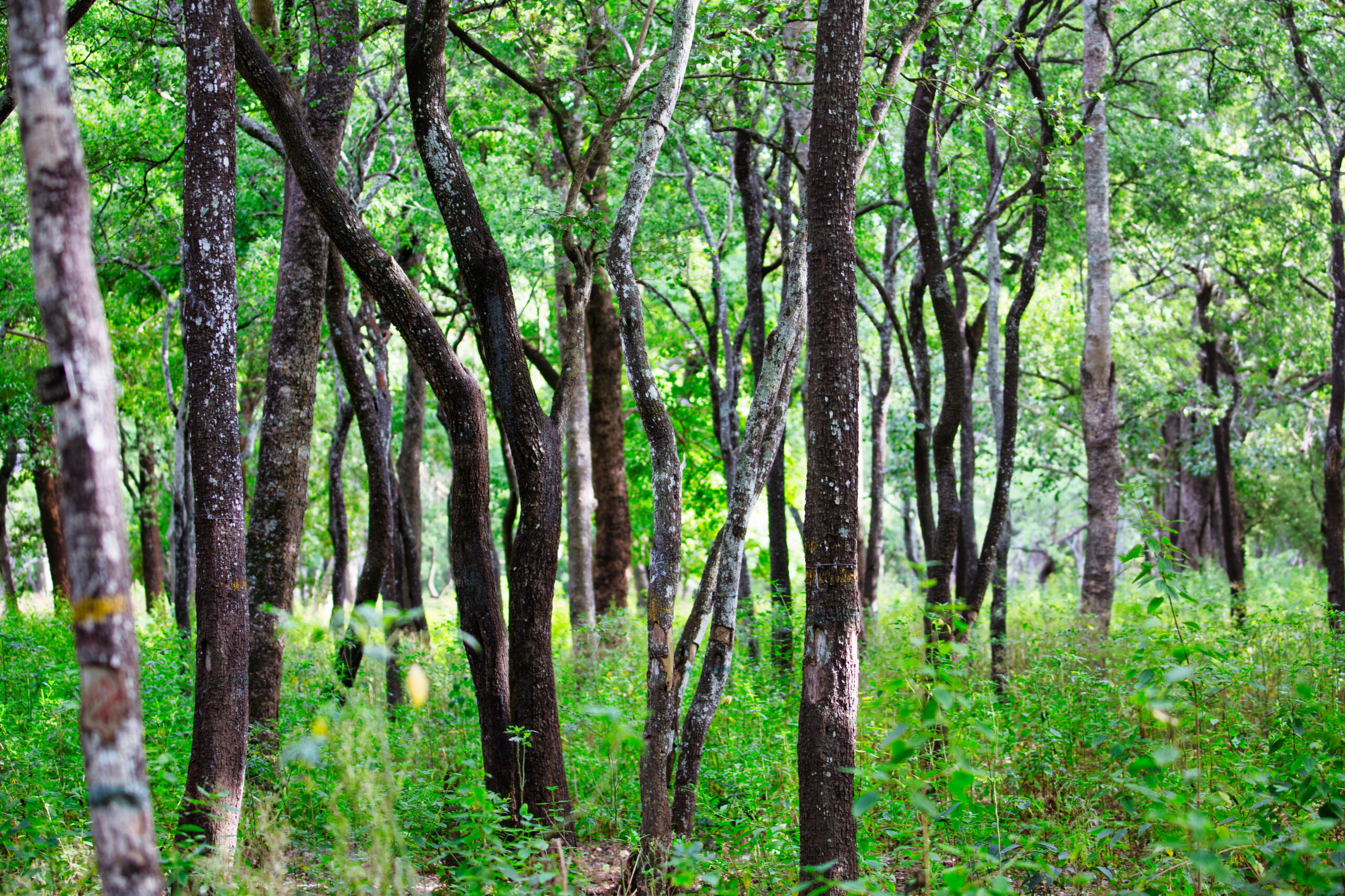The name Sandal (wood) is derived from the Sanskrit “chandana” meaning “white, bright like the moon, fragrant”. Sandalwood belongs to the Santalaceae family of the genus Santalum. Santalum album oil (Indian Sandalwood) represents the highest quality of all Sandalwood oils. Other oils derived from the genus Santalum are Santalum spicatum (Australian Sandalwood), Santalum paniculatum (Hawaiian Sandalwood), and Santalum austrocaledonicum (Pacific Sandalwood).
Sandalwood from India is a semi-parasitic evergreen tree of medium size reaching a height of approximately 6 to 9 meters. It needs several trees as host for its roots. The trunk is greyish brown with many glabrous slender twigs, the leaves being leathery, the petals small and purple. The tree has to be at least 30-40 years old to produce a high level of quality wood, but an age of 80 years or above is given preference. The fruits are pea-sized and used for necklaces much estimated for ritual purposes and also in ornaments.
Sandalwood trees are felled and the remaining roots are dug up. Normally the trunk is left on the ground for several months, so the ants can eat away the sap, wood which is worthless for commercial purposes. For fast use, the trunk is washed and the bark removed. Then the wood is cut into smaller pieces and these chopped into very small chips which are then distilled. The essential Sandalwood oil is mainly derived from the heartwood.

The precious heartwood is also used for furniture because it is resistant to ants and other insects. Sandalwood oil is semi-viscous, light-yellow, and exudes a balsamic, sweet, slightly spicy-woody fragrance. GC and MS analysis show main constituents being ?-santalol (45.8%), ?-santalol (20.6%), ?-sinensal (9.4%), epi-?-santalol (3.3%), and others.
Sandalwood album type originates from East and South India. The highest quality of Sandalwood is thought to come from Mysore region of the province of Karnataka, Southern India. In ancient times the Indian sub-continent was famous for its precious goods such as gold, gems, spices, fine textiles, and perfumes. Sandalwood belonged to these prestigious goods which were exported along the ancient coastal trading routes to the Persian Gulf. The traditional term ‘wooden gold’ for Sandalwood is an expression of its high esteem over all these centuries. Due to their high value, the trees have been permanently endangered via poaching and clear-cutting of vast areas. Since 1998 Sandalwood has been declared as “vulnerable” by the International Union for the Conservation of Nature, and the harvesting and export of wild-grown Indian trees is highly restricted. Despite strong control by the government of India many trees are still cut down illegally and smuggled out of the country.
A special oil – wide span of functions
Being one of the most ancient essential oils and certainly, one of the most outstanding Sandalwood has been used for thousands of years in ancient India for ritualistic purposes. Sandalwood has a spiritual tradition in Indian culture comparable to Frankincense and Myrrh in ancient Egypt. It is commonly used in Mala beads expressing the divine status it is given by the population. It is believed to be most pleasing to the Gods, since it balances the desires and transforms the ego, unfolds humility in man, and supports the mind to concentrate and to maintain alertness during meditation, prayer, and contemplation. Paul Twitchell, in ‘Herbs, The Magic Healers’ reports that in some parts of India in mid-April women mix Sandalwood with Rosewater and sprinkle it all around where they go. It is a symbol of washing away the impurities of the old year and starting “fresh” for New Year. Sandalwood powder is used as an embalming paste on “Shiva lingas” in temples of Lord Shiva. A vast majority of Hindus wear a small mark of this paste on their forehead (“tilak” or “bindi”) right between the eyes. It is supposed to keep the ‘third eye’ cool and to protect it.
This traditional positioning of Sandalwood paste on the “Ajna chakra”, the energy center on the forehead, is more than just cultural. Sandalwood has a connection with our visionary capacities which are linked psycho-physiologically to certain glands of our brain, in this case, the Pituitary and the Pineal gland. The latter, for the famous French Philosopher René Descartes, was the seat of the soul. And the Pineal gland is linked to our Melatonin production, this powerful hormone that is also responsible for our circadian (day and night) rhythm. Experiences have shown that Sandalwood unlocks cellular memories which may have to do also with the Amygdala, our stress and trauma center inside the limbic system. Using a few drops of Sandalwood on the forehead can lead spontaneously to stronger concentration, easing emotional cramping, feeling of being energized with larger “inner space”. The oil has also good effects in case of insomnia, inner restlessness, and nervous exhaustion. In Ayurvedic medicine, Sandalwood is particularly used for its cooling and soothing influence on the nervous system and for the treatment of anxieties. The paste of Sandalwood powder, applied on the forehead, is often not only ritual but also applied as a remedy against headache. Sandalwood fragrance, be it via incensing the wood or by using the oil in a diffuser, creates an atmosphere of tranquillity, reducing negative feelings, tensions and depression. And a whiff of a spray of Sandalwood hydrolate onto the face is a quick means to engender a pleasant cooling effect in case of over-heating of the system.

As to the physiological effects of Sandalwood oil, there is a large array of proven benefits:
• Sandalwood relieves respiratory problems and treats gastroenteritis
• It is also helpful in case of muscular cramps
• Sandalwood purifies the blood
• It is a good anti-inflammatory agent, esp. for the urogenital organs
• It accelerates the speed of metabolic functioning, helps to increase fat metabolism (against problems of cellulitis)
• It enhances hormonal production in men
• Sandalwood diminishes fever and makes it easier to support heat and thirst
• It acts as a mild sedative and may be used to ease pain
• Sandalwood has also interesting healing and vitalizing properties for the skin.
• In cases of eczema, acne, dermatitis, herpes, and other skin problems, but also as a rejuvenator against wrinkles, scars, and a nourisher of the skin it reveals its miraculous cosmetic properties.

Scientific Research
Cancer:
Sandalwood oil has been documented by research at Brigham Young University for its ability to inhibit the growth of some types of cancer cells. It could well be that there is a subtle connection between the powerful psycho-spiritual effects of Sandalwood with its ability to remove negative programming from the cells and certain tumorous formations in the system.
“In two papers published in 2013, Saraswati reported that alpha-santalol, the primary component of SAO, is anti-angiogenic and inhibits the growth of hepatocellular carcinoma and prostate tumors in vitro and in vivo. A common mechanistic feature in these studies seems to be the ability of the oil to cause cell cycle arrest.”
https://www.ncbi.nlm.nih.gov/pmc/articles/PMC5749697/
“A recently published study examined the effects of essential oil from Santalum austrocalidonicum trees on human breast cancer cell lines (MCF-7) and non-tumorigenic epithelial breast cells. The essential oil showed selective cytotoxicity toward the MCF-7 breast cancer cell line… It should be noted that the spectrum of components in Santalum austrocalidonicum oil differs from that seen in Santalum album, but the general phenomenon observed might explain, in part, why Sandalwood oil seems to be preferentially cytotoxic towards cancerous cell lines.”
https://www.ncbi.nlm.nih.gov/pmc/articles/PMC5749697/
Smelling Sandalwood:
“We learn as toddlers that we hear with our ears, feel with our skin, and smell with our nose. An intriguing new study shows that we also have receptors for smell in our skin. The scent of Sandalwood, specifically, was found to facilitate wound healing and skin regeneration. Science Daily reports that researchers at the Ruhr-University Bochum/Germany have discovered that keratinocytes, the cells which form the outer layer of skin, contain olfactory receptors… Among these receptors is one called OR2AT4. What the RUB researchers discovered was that, when the scent of Sandalwood activates those receptors, a calcium-dependent signal pathway is triggered, which leads to greater cell proliferation and quicker migration of skin cells, which is important for repairing damaged skin.”
http://www.inquisitr.com/1460384/your-skin-has-receptors-for-smell-study-shows- scent-of-Sandalwood-can-help-heal-wounds/#p4fB7qudRpguo8SV.99
Anti-microbial:
“In 1979 Australian Sandalwood essential oil demonstrated excellent effectiveness against the bacteria Staphylococcus aureus. It showed to be stronger than Tea Tree oil.”
https://essentiallyaustralia.com.au
Remedy against Cystitis:
“Cystitis is caused by inflammation in the bladder. That said, Sandalwood has both antiseptic and anti-inflammatory properties that can help you to treat your cystitis safely and effectively… Treating cystitis with Sandalwood oil is simpler than you think. First, you will need to prepare a warm bath. To this, you will need to add a cup of Dead Sea salts and four drops of Sandalwood oil. Sit in the bath for at least fifteen minutes. Due to the antiseptic properties of these two ingredients, they will help to fight the infection. Continued use of this remedy will keep the infection at bay and prevent further outbreaks.”
https://www.thesummitvanuatu.com/Sandalwood-oil-cystitis/
An experience:
“I have had bad acne for my entire adult life, tired of all kinds of expensive treatments and products, none helped. When Liz handcrafted face balm with essential oils for me, I was skeptical at first, but the result turns out to be better than wonderful! In just less than 3 weeks, I have clearer skin, more even skin tone, less oily T-zone, it is AMAZING! I can’t thank her enough, now I am a true believer in essential oils!… Good to know. The essential oils used are Sandalwood, Frankincense, Myrrh, and Geranium.”
Jade Lim, Singapore

Some recipes
Urinary tract infections (Dr. Willem)
• Sandalwood
• Lavender
• 4 drops in honey, to be taken 3 times a day
Menstrual pain (Lydia Bosson)
• Sandalwood: 20 drops
• Neroli: 10 drops
• Cistus ladaniferus: 1 drop
• in Macadamia or Apricot vegetal Oil: 30 ml
Massage the lower abdomen 5 days, before and during menstruation with the mixture
Anxiety and depression during pregnancy
“Happy pregnancy” oil (Purchon)
• Sandalwood or Ylang-ylang: 1 drop
• Grapefruit or Rose Geranium: 2 drops
• Lavender or Mandarin: 2 drops
• in 1 teaspoon of Grapeseed vegetal oil
Choose a time when you are alone, with about 30 minutes of peace and quiet ahead of you. First, take a hot water bottle; fill it with hot water and place it under your neck, the heat will help you relax. Then run a warm bath, and add the product by shaking the water. Use the suspended droplets to massage the stomach and chest. Relax, talk to your baby and forget your worries.
Wrinkles (Dr. Telphon)
• Sandalwood: 1 ml
• Bay Laurel: 1 ml
• Palmarosa: 1 ml
• in Apricot Kernel vegetal Oil: 15 ml
• Wheat Germ vegetal oil: 15 ml
• Borage vegetal oil: 15 ml
• Evening Primrose vegetal oil: 15 ml
• Jojoba vegetal oil: 15 ml
Apply morning and evening to the skin
Lotion for damaged hair (Nerys Purchon)
• Sandalwood: 2 drops
• Clary sage: 2 drops
in Castor vegetal oil: 2 teaspoons
• + 1 beaten egg yolk
• + 1 teaspoon of liquid honey
• + Milk powder
In a bowl, mix the beaten egg yolk, Castor oil, and honey, then add the necessary milk powder to form a smooth paste. Then stir in the essential oils. Spread the mixture over the hair and scalp. Cover the head with a warm wet towel. Leave on for 20 minutes before shampooing lightly.

Skin
Fading hyperpigmentation (Living Libations)
Nature generously provides us a few skin-clearing solutions. Rich in antioxidants and skin regenerating energy, essential oils are superheroes for hyperpigmented skin. Applied to the skin, the essential oils of
• Sandalwood
• Geranium
• Frankincense
• Carrot seed
• Lavender
• Cape chamomile
• Rose
are especially effective at improving the appearance of hyperpigmentation.
Skin rejuvenator
“Sandalwood accelerates the speed of metabolic functioning, helps digestion of fat and transformation of fat deposits into sugar (cellulitis)… Sandalwood may have application in all manner of skin conditions and generally acts as a rejuvenator and nourisher of the skin. It reveals its miraculous ‘cosmetic’ properties.”
https://aromachat.com/essential-oil-profiles/sandalwood-essential-oil-santalum-album-87/
Wood is Earth starting to breathe
A discovery in the province of New Brunswick /Canada in 2011 revealed that about 400 million years ago Nature developed for the first time the earliest known plants to grow wood – and with that to rise high towards the Sun. And these beings thanks to their “green breathing” were vital to change the atmosphere of our planet into a liveable place for millions of life forms including us humans…
It is something truly miraculous: The mineral imbibed, non-organic soil under the “dictate” of cosmic energies and Prana develops from the “below” a wonderful organic vegetal gesture: stretching in an anti-gravitational longing towards the “above” and creating the most beautiful beings of vitality and light on Earth: the trees. And especially their stem, “through which the plants reveal themselves as belonging to the earth’s self-consciousness” (Rudolf Steiner) is at the same time that central organ “through which the plants express the earth’s surrender to the activity of the sun beings” (Rudolf Steiner). And this polarity – away from Light into the Earth via the root and high up to the Light via the stem, and the leaves, and the flowers – must be a very special dynamic factor of cosmic impulses which determine whether the wood of a tree can become fragrant like in Sandalwood or not.
In other words: the wooden stem or trunk is a kind of messenger between the roots and the leaves and the flowers. In a sense, the wooden stem is just – at first sights – like an extension of the root. But of course, it is much more. Such trunk with its “heart-wood” in its center has a huge “responsibility”. And it has even to breathe –not only that the leaves breathe, but the wood too! This was discovered not long ago – the wood has its own way to breathe, to expand, and contract in a special form of circadian rhythms. And, as we saw, it has to send the pulsations from the roots below and from the leaves and the flowers above back and forth. “Mercury in action”, would the alchemists say. And then… sometimes the wood becomes fragrant – the Sulfur element steps in – showing its connection with the floral process, but reaching deeper where it will be stored and not withered away like in the flower. And this also happens – like in Sandalwood oil – thanks to its special “heavier” or denser bio-chemistry.

We remember? The Earth element is linked to the sense of smell according to Ayurveda… And this “attitude” or desire to become fragrant has also something else to say: Look, I am not just a simple wooden trunk! I can smell like a flower, my whole being is root and flower in ONE. As Rudolf Steiner said so nicely once for the Rosewood tree: “In the Rosewood tree the wood starts to blossom”. And in the Sandalwood tree, not less, the wood starts to blossom and develops the most subtle precious “messenger perfume” which the Indians could only interpret as being made for the humans to attract the Gods to their tables…
Yes, it is beautiful and necessary to see the “weaving of Nature” via certain perspectives which make us comprehend the amazing connections between the world of Spirit and matter. I must say that the father of Anthroposophy, Rudolf Steiner, has gone really far in this holistic understanding of the relationship of plant and man when he says here for example:
“We stand before the gigantic trees in the primeval forest, before the quiet violet or lily of the valley, and we look at them as single individualities, yes, but in such a way that we say, there the spirit lives throughout space, expresses itself to us — sun spirit! Earth spirit! Just as we recognize in a human being the piety or impiety of his soul, so we can come to an impression, from what looks at us out of the plants, of what lives as earth spirit, as sun spirit, of how they battle with one another or are in harmony. There we feel ourselves as living and weaving within the spirit.”
The Spirit in the Realm of Plants, Lecture by Dr. Rudolf Steiner
Berlin, December 8th, 1910
https://wn.rsarchive.org/Lectures/19101208p01.html
Yes, Sandalwood rather harmonizes the godly side in us humans – the energies between the root and the crown chakra – and thereby also the “polar organs” high above and way below in our physiology. Which means: enabling the contact between the elements of “heaven and earth” so that communication with the Divine becomes enhanced. No wonder that in Ayurveda Sandalwood is used for balancing all Doshas with its special connection to the nervous system for relieving stress and anxieties. Sandalwood’s subtle resonance allows man to let energy flow beyond duality and its restrictions and start to live in tune again with his intrinsic harmony and bliss.
As a spiritual “power plant” Sandalwood is definitely linked to the experience of the sacred. It uplifts and transforms vital and basic energies thereby opening the heart for the Divine intelligence in man.
An amazingly subtle pranic energizer helping to make the “heart-wood” of our being fragrant and uplifted onto the soul level.
